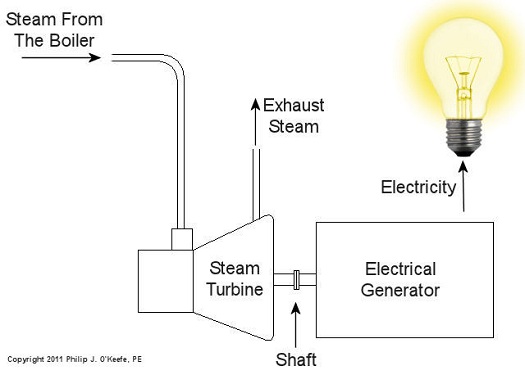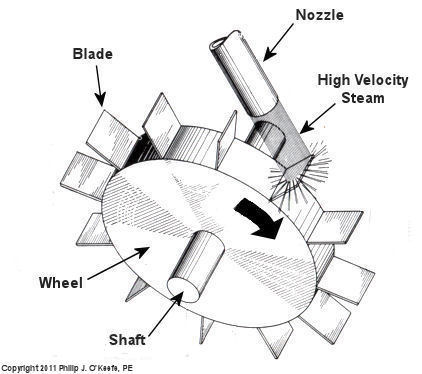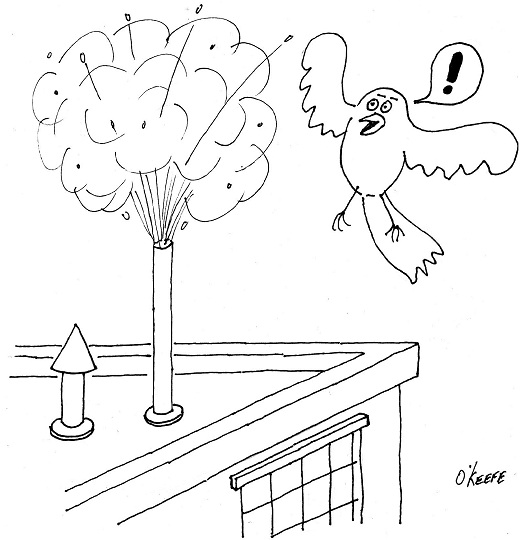|
When I was a kid I didn’t have video games or cable TV to help me occupy my time. Back then parents tended to be frugal, and the few games I had were cheap to buy and simple in operation, like the plastic toy windmill I’d play with for hours on end. All I had to do to make it spin was take a deep breath, pucker my lips together, fill my cheeks with breath, then blow hard into the windmill blades. Its spin was fascinating to watch. Little did I know that as an adult I would come to work with a much larger and complex version of it, in the form of a power plant’s steam turbine. You see, when you trap breath within bulging cheeks and then squeeze your cheek muscles together, you actually create a pressurized environment. This air pressure buildup transfers energy from your mouth muscles into the trapped breath within your mouth, so that when you open your lips to release the breath through your puckered lips, the pressurized energy is converted into kinetic energy, a/k/a the energy of movement. The breath molecules flow at high speed from your lips to the toy windmill’s blades, and as they come into contact with the blades their energy is transferred to them, causing the blades to move. A similar process takes place in the coal power plant, where steam from a boiler takes the place of pressurized breath and a steam turbine takes the place of the toy windmill. If you recall from my previous article, the heat energy released by burning coal is transferred to water in the boiler, turning it to steam. This steam leaves the boiler under great pressure, causing it to travel through pipe to the steam turbine, as shown in Figure 1. Figure 1 – A Basic Steam Turbine and Generator In A Coal Fired Power Plant At its most basic level the inside of a steam turbine looks much like our toy windmill, of course on a much larger scale, and it is very appropriately called a “wheel.” See Figure 2. Figure 2 – A Very Basic Steam Turbine Wheel The wheel is mounted on a shaft and has numerous blades. It makes use of the pressurized steam that has made its way to it from the boiler. This steam has ultimately passed through a nozzle in the turbine that is directed towards the blades on the wheel. This is the point at which heat energy in the steam is converted into kinetic energy. The steam shoots out of the nozzle at high speed, coming into contact with the blades and transferring energy to them, which causes the turbine shaft to spin. The turbine shaft is connected to a generator, so the generator spins as well. Finally, the spinning generator converts the mechanical energy from the turbine into electrical energy. In actuality, most coal power plant steam turbines have more than one wheel and there are many nozzles. The blades are also more numerous and complex in shape in order to maximize the energy transfer from the steam to the wheels. My Coal Power Plant Fundamentals seminar goes into far greater detail on this and other aspects of steam turbines, but what I have shared with you above will give you a basic understanding of how they operate. So to sum it all up, the steam turbine’s job is to convert the heat energy of steam into mechanical energy capable of spinning the electrical generator. Next time we’ll see how the generator works to complete the last step in the energy conversion process, that is, conversion of mechanical energy into electrical energy. _____________________________________________ |
Posts Tagged ‘steam’
Coal Power Plant Fundamentals – The Steam Turbine
Sunday, February 20th, 2011Tags: boiler, coal power plant training, electric utility training, electrical generator, engineering expet witness, forensic engineering, fossil fuel, generating station, heat energy, high pressure steam, kinetic energy, nozzle, power engineering, pressure, seminar, steam, steam pipe, steam turbine, turbine blade, turbine generator, windmill
Posted in Engineering and Science, Personal Injury, power plant training | 5 Comments »
Sound and Its Control
Sunday, November 21st, 2010| How do they do it? Your teenager is busily doing his homework, the sound on their stereo speakers cranked up way past the point of your comfort. As the heavy bass beats against your eardrums, their sound waves continue to travel throughout the house, crashing into walls and uprooting small objects from their positions on shelves. Thankfully, controlling this uncomfortable sound level is relatively easy, as you scream out, “Turn that music down!”
Many dangerously loud sounds are not so easily controlled, as when they take place in industrial settings. Here, when complex machinery and manufacturing processes are at full tilt, one can’t just turn a single knob or pull a plug to gain relief. Controlling sound levels in factories, power plants, and construction sites is often a complex task, relegated to engineers with state of the art equipment meant to measure and assess sound exposures in order to devise a strategy to control them. Let’s take a look at a few of these control methods. For our example, we’ll consider the challenge faced by a fictitious company, Widget USA. Business has picked up, and they need to install an additional manufacturing line in their factory. Now widget manufacturing machinery is notoriously noisy, and management is thinking ahead about protecting widget line workers from potentially dangerous sound levels. Their manufacturing engineers dutifully keep this in mind while devising their requirements specification, a list of “must haves” routinely included in quotation requests to potential manufacturers bidding on the job. Of utmost concern is to limit the number of decibels (dB) that the new widget machine can produce. If a manufacturer under consideration is unable to meet these requirements, Widget USA will take their business elsewhere. This methodology essentially nips the excessive noise problem in the bud, eliminating the noise source before it is introduced into the factory, and this is by far the best way of dealing with our scenario. Well suppose things aren’t as neat for Widget USA. Their factory contains many existing manufacturing lines with old, noisy machines. Sure, they’d like to replace them with newer, quieter ones, but there’s a problem, and it’s one all-too familiar to most companies: the expense involved. How can they most effectively deal with this situation? Perhaps Widget USA can modify their existing machinery, or perhaps their overall noise reduction objectives can be achieved by simply replacing worn parts that have a tendency to vibrate. If this measure isn’t sufficient, perhaps sound barriers can be introduced. Whether these are installed around entire machines or parts thereof, they are often effective at absorbing excessive noise. Barriers such as these are made of materials like plastic foam and mass loaded vinyl (MLV) which serve to muffle sound waves. Yet another approach to noise containment is to provide workers in the vicinity of the machinery with sound-absorbing personal safety equipment, ear plugs and the like. If the noise present is loud enough, perhaps a wall, reminiscent of the type often built along stretches of populated highway can be erected. Yet another way to deal with undesirable sound levels is to divert the noise to a location not normally occupied by humans. This is the tact often taken with industrial boilers. Their highly pressurized steam expands so rapidly it can create a deafening roar, and engineers often design piping systems which stem from the safety valve on the boilers themselves up to the roof of the building housing them. In this way the steam and its accompanying noise is safely redirected outside, where only the birds passing overhead will be bothered by it. This wraps up our discussion on sound, its measurement and containment. Perhaps you’ve learned a trick or two to help alleviated unwanted sounds in your environment, whether it’s produced by your teen or your neighbor’s leaf blower. _____________________________________________
|
Tags: dB, decibel, engineering expert witness, forensic engineer, hearing loss, hearing protection, leaf blower, mass loaded vinyl, MLV, noise mitigation, noisy machinery, power plant, safety valve, sound barrier, sound control, sound level, sound proofing, sound waves, steam
Posted in Engineering and Science, Personal Injury, Product Liability, Professional Malpractice | Comments Off on Sound and Its Control






